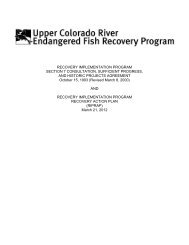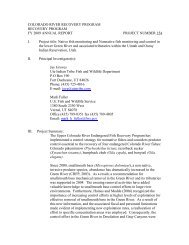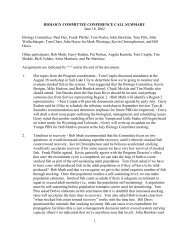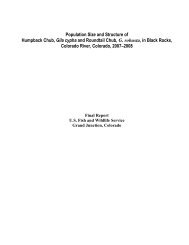K. R. Bestgen, K. A. Zelasko, and G. C. White. Monitoring ...
K. R. Bestgen, K. A. Zelasko, and G. C. White. Monitoring ...
K. R. Bestgen, K. A. Zelasko, and G. C. White. Monitoring ...
You also want an ePaper? Increase the reach of your titles
YUMPU automatically turns print PDFs into web optimized ePapers that Google loves.
on capture rates of untagged razorback suckers, which is an important part of recovery goals that<br />
require recruitment at levels that offset mortality rates (USFWS 2002). However, the restrictive<br />
assumption of that approach is that all untagged fish are wild-produced, which we know is likely<br />
not true, because of stocking of “excess” fish in various places, as well as tag loss, tag failure,<br />
improper tag scanning <strong>and</strong> other issues that result in a non-detection of a once-tagged fish.<br />
Because recapture rates are already relatively low, careful tag detection <strong>and</strong> data recording<br />
becomes even more vital to effective parameter estimation. <strong>Zelasko</strong> et al. (2010) summed up<br />
this issue regarding their use of tagged fish recaptures as follows:<br />
“Of the 4,010 total razorback sucker capture events we examined, at least<br />
275 records (6.9%) had PIT tag errors which made them unusable.<br />
Another 328 capture records (8.2%) did not have associated stocking<br />
data, which could be the result of captures of wild untagged fish, captures<br />
of hatchery-reared untagged fish, loss of tags, failure of equipment to<br />
detect tags, or failure to scan fish prior to stocking. Accurate tagging, tag<br />
detection, <strong>and</strong> data recording are minimal requirements to underst<strong>and</strong><br />
provenance of captured fish (hatchery or wild) <strong>and</strong> recruitment rates of<br />
razorback suckers.”<br />
Some of those errors or problems can be accommodated in an analysis informed by things like<br />
tag loss rates, but presence of large numbers of untagged fish as juveniles, when large numbers<br />
of unmarked early life stages are released one to several years prior is problematic <strong>and</strong> not likely<br />
treatable in an analysis. Those factors will frustrate attempts to estimate recruitment rates of<br />
wild fish until they are minimized to a much greater level.<br />
Another approach that would aid identifying actual wild-produced juveniles from<br />
untagged or otherwise unrecognizable hatchery fish would be to employ trace element analyses<br />
of structures such as scales. Investigators have used this technique to differentiate wild from<br />
stocked fish of other species <strong>and</strong> preliminary analyses are underway using scales from San Juan<br />
River razorback suckers (Flem et al. 2005, S. Platania, pers. comm.). Preliminary results show<br />
clear differences between element concentrations in scales consistent with when fish were in the<br />
hatchery <strong>and</strong> were then subsequently captured in the river after a reasonably long time interval.<br />
Verification of the number <strong>and</strong>, potentially, rates of wild fish recruitment would be very useful<br />
<strong>and</strong> presumably require little additional work other than the analysis of the scales themselves,<br />
since non-regenerated scale samples could be collected when untagged fish were noted in other<br />
ongoing sampling programs.<br />
46










